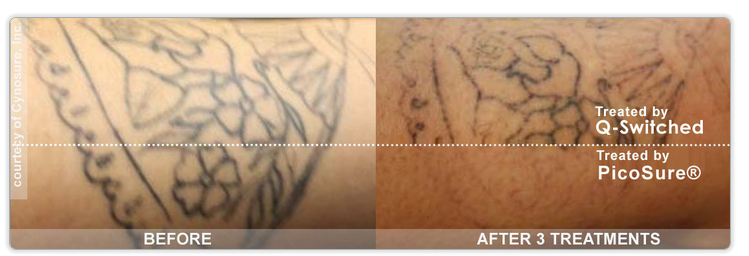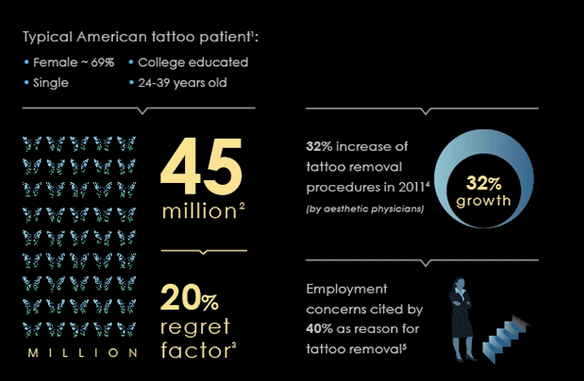Tattoo Removal
Centrally located in Southampton, PA and serving Philadelphia, Bucks, and Montgomery Counties, The Kole Plastic Surgery Center uses the PicoSure® laser for patients interested in tattoo removal.
Over hundreds of years, tattooing has developed into a common way to display independence, artistic expression and individuality. Indeed, studies show that roughly 21 percent of American adults have a tattoo, including 60 percent of women aged 18 and older.
However, this has also led to increased demand for tattoo removal. Modern aesthetic lasers provide a safer and more effective means of removing ink from the skin. Lasers do this by targeting the pigment with a high-intensity beam of light, which causes it to degrade into smaller particles. Afterward, the body absorbs the ink, and the tattoo fades until it’s no longer visible. For over two decades, Q-Switched lasers have been the gold standard of tattoo and skin spot removal.
Today, the PicoSure® laser creates a photomechanical impact with its ultra-short pulses, effectively smashing the ink into fine particles. Because these are so tiny, they’re easier for the body to absorb and are eliminated via natural bodily processes. Because of this, each PicoSure® treatment will cause the tattoo to become lighter and disappear faster than ever.
PicoSure® is the first significant advancement in laser tattoo removal in two decades for these reasons:
PicoSure® utilizes PressureWave™ technology to more thoroughly disrupt the tattoo ink. This offers improved clearance in fewer treatments and causes less skin injury. As the ink is broken down into smaller particles, the immune system removes them from the body. With each treatment, the tattoo becomes more faded. The destruction of tattoo ink pigment is far more complete with PicoSure® than the traditional YAG tattoo removal devices.

Some minor discomfort is to be expected, and most people liken the sensation to that of a rubber band snapping against the skin. However, this can vary with each patient. We will do everything we can to ensure that you experience as little pain or discomfort as possible.
With that in mind, we often apply a high-potency topical anesthetic cream or in more sensitive patients may actually use an injectable local anesthesia and routinely use a Zimmer Chiller, which blows cold air over the skin, during the procedure to help you stay comfortable.
During your consultation appointment, we’ll measure the tattoo and estimate how many treatments will be necessary to remove it completely. If the tattoo is very large, like a sleeve, we do not price it by the square inch. Instead, we’ll give you a custom price that depends on the size of the tattoo and the expected difficulty of removal.
Here is a PicoSure Tattoo Removal Pricing Guide:
All procedures performed by Dr. Kole not a technician.
The Kole Plastic Surgery Center accepts cash, check, and credit card (MasterCard®, Visa®, American Express®, Discover®) as acceptable forms of payment.
Financing is also available through CareCredit®, United Medical Credit, and Advanced Care.

Each tattoo responds differently to the treatment depending on various factors. There are differences in ink color and composition, the density and depth of placement, your skin type, and unique immunological factors. Tattoos that are over bony prominences and smokers require additional treatments. Ink originating in Asia is of higher quality and is more difficult to remove. Ink from Mexico and amateur tattoos require fewer treatments. Estimating the number of treatments required is merely an educated guess, and you may require more or fewer treatments than stated. At your consultation, Dr. Kole will estimate how many treatments you’ll likely need to remove the tattoo.
Tattoo removal is a gradual process that relies on your immune system. It’s recommended to space treatments at least six weeks apart. As the tattoo becomes less apparent, treatments may need to be further apart – about every eight weeks.
During the procedure, the tattoo may blanch white for a short time. It will then slightly swell and turn red, but this typically disappears within a few hours. It’s important to cover your tattoo with an ointment and a bandage the first day after treatment. In most cases, it will feel like a sunburn and shouldn’t hurt unless touched. It’s also important to keep it covered between treatments to avoid sun damage and darkening of the skin. During your consultation, Dr. Kole will provide you with specific instructions.
Currently, PicoSure® is only available for people with skin types I through IV. People with type V (black) skin cannot receive PicoSure® treatment without going a small test spot to see if the laser reacts with the patient’s own melanin. The procedure also cannot be used to remove cosmetic tattoos (permanent makeup).
Do you have a tattoo that no longer suits your lifestyle or reminds you of a past unpleasant experience? Now may be the time to consider laser tattoo removal by Kole Plastic Surgery. As a board certified plastic surgeon, Dr. Kole offers treatments for tattoo removal for men and women in Southampton, PA, Philadelphia County, Bucks County, Montgomery County and surrounding areas of Bucks County, PA. The treatments eliminate the pigments without scarring your skin. In just a few treatments, your unwanted tattoo will be nothing more than a distant memory. Contact us today to schedule a personal consultation.

215-315-7655
Kole Plastic Surgery Center
We firmly believe that the internet should be available and accessible to anyone, and are committed to providing a website that is accessible to the widest possible audience, regardless of circumstance and ability.
To fulfill this, we aim to adhere as strictly as possible to the World Wide Web Consortium’s (W3C) Web Content Accessibility Guidelines 2.1 (WCAG 2.1) at the AA level. These guidelines explain how to make web content accessible to people with a wide array of disabilities. Complying with those guidelines helps us ensure that the website is accessible to all people: blind people, people with motor impairments, visual impairment, cognitive disabilities, and more.
This website utilizes various technologies that are meant to make it as accessible as possible at all times. We utilize an accessibility interface that allows persons with specific disabilities to adjust the website’s UI (user interface) and design it to their personal needs.
Additionally, the website utilizes an AI-based application that runs in the background and optimizes its accessibility level constantly. This application remediates the website’s HTML, adapts Its functionality and behavior for screen-readers used by the blind users, and for keyboard functions used by individuals with motor impairments.
If you’ve found a malfunction or have ideas for improvement, we’ll be happy to hear from you. You can reach out to the website’s operators by using the following email
Our website implements the ARIA attributes (Accessible Rich Internet Applications) technique, alongside various different behavioral changes, to ensure blind users visiting with screen-readers are able to read, comprehend, and enjoy the website’s functions. As soon as a user with a screen-reader enters your site, they immediately receive a prompt to enter the Screen-Reader Profile so they can browse and operate your site effectively. Here’s how our website covers some of the most important screen-reader requirements, alongside console screenshots of code examples:
Screen-reader optimization: we run a background process that learns the website’s components from top to bottom, to ensure ongoing compliance even when updating the website. In this process, we provide screen-readers with meaningful data using the ARIA set of attributes. For example, we provide accurate form labels; descriptions for actionable icons (social media icons, search icons, cart icons, etc.); validation guidance for form inputs; element roles such as buttons, menus, modal dialogues (popups), and others. Additionally, the background process scans all the website’s images and provides an accurate and meaningful image-object-recognition-based description as an ALT (alternate text) tag for images that are not described. It will also extract texts that are embedded within the image, using an OCR (optical character recognition) technology. To turn on screen-reader adjustments at any time, users need only to press the Alt+1 keyboard combination. Screen-reader users also get automatic announcements to turn the Screen-reader mode on as soon as they enter the website.
These adjustments are compatible with all popular screen readers, including JAWS and NVDA.
Keyboard navigation optimization: The background process also adjusts the website’s HTML, and adds various behaviors using JavaScript code to make the website operable by the keyboard. This includes the ability to navigate the website using the Tab and Shift+Tab keys, operate dropdowns with the arrow keys, close them with Esc, trigger buttons and links using the Enter key, navigate between radio and checkbox elements using the arrow keys, and fill them in with the Spacebar or Enter key.Additionally, keyboard users will find quick-navigation and content-skip menus, available at any time by clicking Alt+1, or as the first elements of the site while navigating with the keyboard. The background process also handles triggered popups by moving the keyboard focus towards them as soon as they appear, and not allow the focus drift outside it.
Users can also use shortcuts such as “M” (menus), “H” (headings), “F” (forms), “B” (buttons), and “G” (graphics) to jump to specific elements.
We aim to support the widest array of browsers and assistive technologies as possible, so our users can choose the best fitting tools for them, with as few limitations as possible. Therefore, we have worked very hard to be able to support all major systems that comprise over 95% of the user market share including Google Chrome, Mozilla Firefox, Apple Safari, Opera and Microsoft Edge, JAWS and NVDA (screen readers).
Despite our very best efforts to allow anybody to adjust the website to their needs. There may still be pages or sections that are not fully accessible, are in the process of becoming accessible, or are lacking an adequate technological solution to make them accessible. Still, we are continually improving our accessibility, adding, updating and improving its options and features, and developing and adopting new technologies. All this is meant to reach the optimal level of accessibility, following technological advancements. For any assistance, please reach out to
laser tattoo removal philadelphia, tattoo removal philadelphia, laser tattoo removal near me, picosure laser philadelphia, tattoo removal financing, tattoo removal near me